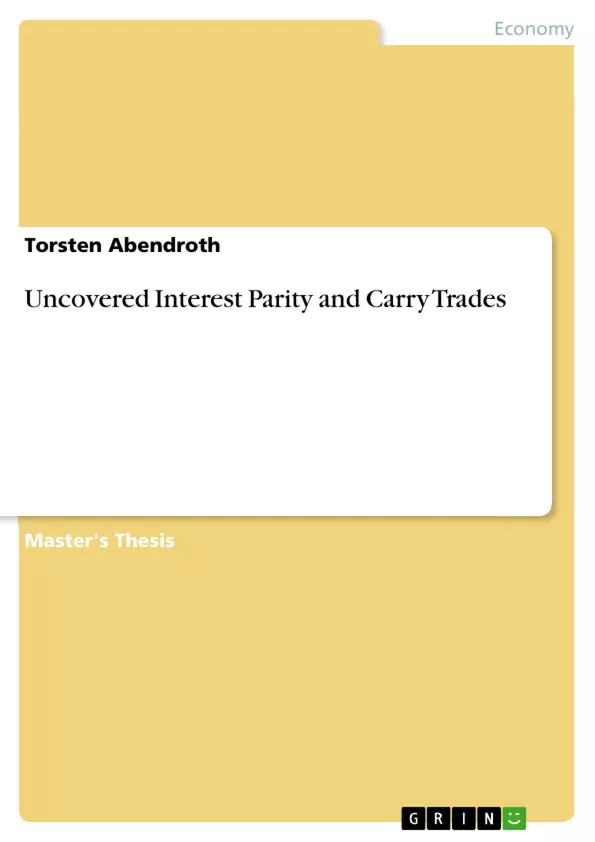The aim of this thesis is to test UIP by implementing an OLS regression analysis for five currency pairs which, according to CFTC data, global turnover data and carry-to-risk ratios, were among the most popular in the investor community. To increase the significance of this thesis for practitioners, the work will use one-month forward contracts which are used frequently by investors and include bid and ask rates in order to account for transaction costs.
In addition, all currency pairs include the US Dollar for reasons of better liquidity, and therefore tighter bid-ask spreads. Moreover, this thesis will present recent findings in literature which try to explain deviations from UIP. Approaches can be separated by the focus on a risk premium, by irrational market behavior or by learning problems and market inefficiency. While most focus is laid on an explanation by a risk premium, it will be shown that it is crucial to combine the different scientific disciplines in order to solve the forward premium puzzle. In addition to this, the thesis will provide an outlook on the future attractiveness of carry trade strategies.
Inhaltsverzeichnis (Table of Contents)
- Introduction
- Theoretical Framework
- Uncovered Interest Parity
- The Forward Premium Puzzle
- Testing of UIP
- Data
- Regression equation and excess return formula
- Results and analysis
- Discussion of recent findings in literature
- Approaches to explain a violation of UIP
- Explanation by risk premium and peso problems
- Explanation by irrationality
- Explanation by learning problems and market inefficiency
- Approaches to explain a partial holding of UIP
- Developed and emerging markets
- Short term and long term maturities
- Approaches to explain a violation of UIP
- Consequences of recent innovations in the foreign exchange market
- Conclusion
Zielsetzung und Themenschwerpunkte (Objectives and Key Themes)
This master thesis aims to explore the uncovered interest parity (UIP) theory and its implications for carry trade strategies in the foreign exchange market. It examines empirical evidence for UIP, analyzing deviations and potential explanations for them. The thesis also investigates recent developments in the foreign exchange market and their impact on the applicability of UIP and carry trade strategies.
- Uncovered Interest Parity (UIP) theory and its empirical validity
- The Forward Premium Puzzle and its explanations
- Carry trade strategies and their profitability
- The role of risk aversion, market inefficiency, and behavioral biases in explaining UIP deviations
- Impact of recent innovations in the foreign exchange market on UIP and carry trades
Zusammenfassung der Kapitel (Chapter Summaries)
- Chapter 1: Introduction provides a brief overview of the topic and outlines the research questions and objectives of the thesis.
- Chapter 2: Theoretical Framework discusses the theoretical foundation of UIP and the Forward Premium Puzzle, presenting the key concepts and hypotheses.
- Chapter 3: Testing of UIP presents the empirical methodology employed in testing the UIP hypothesis and analyzes the results of the regression analysis.
- Chapter 4: Discussion of recent findings in literature reviews different explanations proposed in the literature for the observed deviations from UIP, including risk aversion, irrationality, and market inefficiency.
- Chapter 5: Consequences of recent innovations in the foreign exchange market explores the impact of recent developments in the foreign exchange market on UIP and carry trade strategies.
Schlüsselwörter (Keywords)
The key keywords and focus topics of this thesis include uncovered interest parity, forward premium puzzle, carry trades, risk aversion, market efficiency, behavioral finance, foreign exchange market, and empirical testing.
- Citar trabajo
- Torsten Abendroth (Autor), 2016, Uncovered Interest Parity and Carry Trades, Múnich, GRIN Verlag, https://www.grin.com/document/351449



